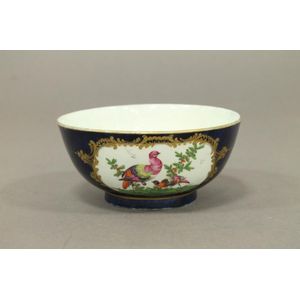Wedgwood Blue Jasper Medallion Bowl
You must be a subscriber, and be logged in to view price and dealer details.
Subscribe Now to view actual auction price for this item
When you subscribe, you have the option of setting the currency in which to display prices to $Au, $US, $NZ or Stg.
- Aphrodite / Venus - In Greek mythology, Aphrodite is the goddess of love, desire and beauty, whilst in Roman mythology she is called Venus.
- Circa - A Latin term meaning 'about', often used in the antique trade to give an approximate date for the piece, usually considered to be five years on either side of the circa year. Thus, circa 1900 means the piece was made about 1900, probably between 1895 and 1905. The expression is sometimes abbreviated to c.1900.
- Cupid Motif - The Cupid motif, which features the Roman god of love and desire, Cupid, was a popular decorative element in classical ornamentation. Cupid was often depicted as a winged, naked baby with a bow and arrow, and was often used to symbolize love and desire.
In classical art and architecture, Cupid motifs were often used as decorative elements on furniture, such as on the legs of chairs and tables, as well as on architectural elements such as friezes and pediments. They were also used as decorative elements in frescoes, mosaics, and other forms of art.
During the Renaissance, Cupid motifs were often incorporated into the decoration of palaces, churches and other grand buildings, as they were seen as symbols of love and fertility. Cupid motifs were also commonly used in the decorative arts of the Baroque period, often appearing in the form of putti, which are small winged cherub figures.
In addition to their decorative use, Cupid motifs were also believed to hold symbolic meaning, as they were thought to evoke feelings of love, desire, and fertility.
This item has been included into following indexes:
-
Wedgwood (England), item types
- bowls 179
- bowls, Jasperware 52
- medallions 38
Visually similar items

A Chinese blue and white porcelain bowl, Qianlong, 18th century, 23 cm diameter

A Chinese blue and white bowl, late Qing Dynasty, late 19th century, the low bowl of ogee profile raised on a ring foot decorated externally with a continuous scene of daily life amidst a boat adorned lake and landscape setting with pavilions and pagodas;

A yellow-ground 'famille-rose' bowl seal mark and period of Daoguang with rounded sides rising from a slightly tapering foot to the gently flared rim, densely painted on the exterior with a composite floral scroll of peony, lotus, lilly and hibiscus on ent

An 18th century Worcester porcelain period sugar bowl with exotic birds painted in gilt scroll cartouches on a scale blue ground. Blue fret mark. C.1765. Width 16.5 cm
